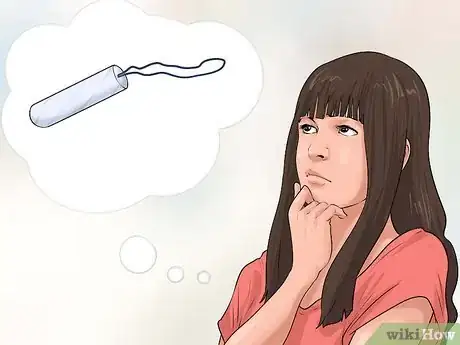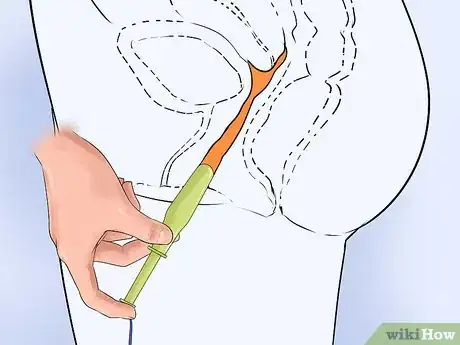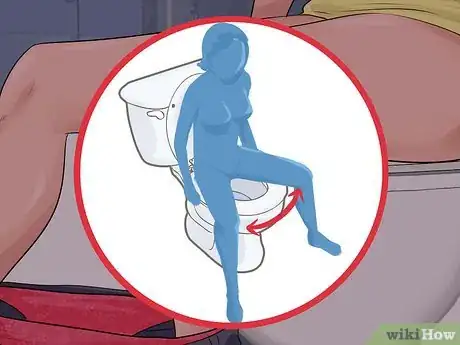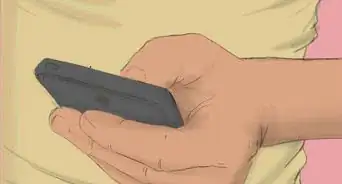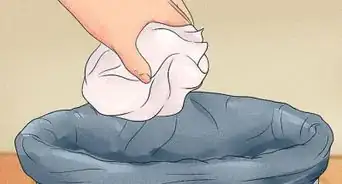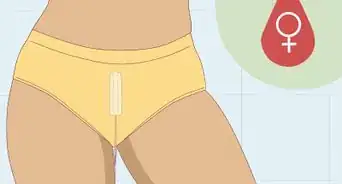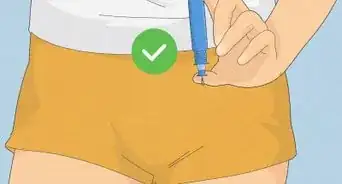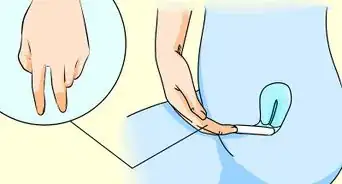This article was co-authored by Rebecca Levy-Gantt, MPT, DO. Dr. Rebecca Levy-Gantt is a board certified Obstetrician and Gynecologist running a private practice based in Napa, California. Dr. Levy-Gantt specializes in menopause, peri-menopause and hormonal management, including bio-Identical and compounded hormone treatments and alternative treatments. She is also a Nationally Certified Menopause Practitioner and is on the national listing of physicians who specialize in menopausal management. She received a Masters of Physical Therapy from Boston University and a Doctor of Osteopathic Medicine (DO) from the New York College of Osteopathic Medicine.
There are 9 references cited in this article, which can be found at the bottom of the page.
wikiHow marks an article as reader-approved once it receives enough positive feedback. This article received 14 testimonials and 81% of readers who voted found it helpful, earning it our reader-approved status.
This article has been viewed 1,153,349 times.
If you’re unaccustomed to it, using a tampon can be awkward and even a bit painful. With some practice and education — including tips and tricks for insertion and removal — you can learn how to use tampons quickly and painlessly.
Steps
Preparing for Insertion
-
1Be aware of the risks. Tampon users are at risk of contracting Toxic Shock Syndrome (TSS), which can be fatal. If you experience ANY of the following symptoms while wearing a tampon, remove the tampon and see a doctor immediately:[1]
- Fever of 102 degrees Fahrenheit (38.89 degrees Celsius) or more
- Vomiting
- Diarrhea
- Muscle aches
- A sunburn-like rash with peeling skin, especially on the palms and soles
- Dizziness, light-headedness, or mental confusion
- Pale, clammy skin (signalling a drop in blood pressure)
-
2Consider a menstrual cup.[2] Menstrual cups are small, flexible cups made out of silicone or latex rubber. Tampons and sanitary napkins absorb your flow; menstrual cups catch and hold it, like how a cup holds water. Because menstrual cups don’t absorb your flow, they boast a lower risk of TSS.
- Menstrual cups are inserted similarly to how tampons without applicators are inserted (i.e. with your fingers).
- You can wear a menstrual cup for 12 hours — much longer than the 4 to 8 hours common for tampons.
- Downsides: it can take time to find a cup that fits you and your flow, and removal can be tricky -- particularly if you’re in public, as you may have to wash out the cup in the restroom sink before re-inserting it.
-
3Choose the lightest-absorbency tampon for your flow. If you have a light flow, don’t buy super-absorbent tampons. If your flow ranges between light and normal, buy one box of each and use the appropriate tampon when needed. Only use super-absorbency tampons if your flow is very heavy.
- Some manufacturers offer multi-packs that contain light and normal tampons, or normal and super, or even light, normal and super.
- Only use tampons once you are already bleeding. Do not insert them in anticipation of your period or to absorb anything else.
- TSS is more likely to occur when super-absorbent tampons are used.[3]
-
4Know where your vaginal opening is.[4] Many young women are afraid of using tampons simply because they lack knowledge about their own anatomy. It’s not their fault; it’s just not something that is commonly taught or discussed. Your vaginal opening is located between your anus and your urethra. Follow these steps to easily find your vaginal opening:
- Standing upright, place one leg up on a chair (the toilet is also fine).
- Holding a hand-held or compact mirror in your dominant hand, move it down between your legs so that you can see your private area.
- With your non-dominant hand, gently spread your labia (the fleshy folds around your vaginal opening). Depending on the size of your labia, you may need to pull them a bit to be able to see your vagina and urethra. If you do need to pull them, be very gentle as they are made up of a sensitive membrane and could tear if pulled apart too roughly.
- Continuing to hold the labia open, move the mirror so that you can clearly see the area beneath the folds.
- You should now see a slit with a small hole above it. The small hole is your urethra; the slit is your vaginal opening.
-
5Practice with your finger. You may find it helpful to practice with your finger before you try inserting a tampon. Treat your finger like a tampon by holding it straight, but not rigid, finding your vaginal opening, and sliding it gently inside.
- Don’t force your finger to stay straight; let it move with the natural curve of your vagina.
- You may find it helpful to place a small drop of water-based lubricant on your finger before-hand.
- Be extra-gentle if you have long nails, as they could scratch the delicate skin of your genital area.
-
6Read the instructions that come with your tampons. The tampons you buy should come with a detailed instruction slip inside the box. The slip should include illustrations of how to insert the tampons. Read over the instructions to familiarize yourself with the process.
-
7Ask for help. If you’re really struggling to find your vaginal opening and figure out how to put in a tampon, ask a female friend or relative to show you how to do it. If you don't feel comfortable doing that, your doctor should be able to either help you or put you in touch with someone who can help you.
-
8Consult a doctor. If, even after trying the tips and tricks in this article, you are still experiencing pain upon inserting a tampon (or anything else, for that matter) into your vagina, see a doctor. It’s possible that you may be suffering from a treatable condition; if this is the case, your doctor can get you the help you need.
- One such condition that causes pain in and around the vagina is called vulvodynia.
Inserting the Tampon
-
1Relax and take your time. If you’re anxious, you’re more likely to clench your muscles, which will make it difficult to insert a tampon. Try to relax. It is unlikely that you will hurt yourself if you go slowly and gently.
- Go slow and pay attention to your body.
- If you simply cannot insert the tampon, don’t force it. Use a sanitary napkin instead and then try again tomorrow. Don’t beat yourself up; most women take some time to get comfortable with using tampons.
-
2Wash your hands well. Be sure to dry them afterward.
-
3Remove the tampon from its packaging. After removing the tampon from its packaging, check to ensure that it’s not faulty in any way. Tug the string lightly to make sure it's secure. If you're using a tampon with an applicator, make sure the string is hanging outside the barrel.
- If you must place the tampon down before inserting it, ensure that you place it on a clean surface.
-
4Pull down your bottoms and get into a comfortable position. Which position you choose for insertion will depend upon your unique anatomy and personal taste. Many girls sit on the toilet with their legs apart when inserting a tampon. If that feels uncomfortable to you, stand upright and place one foot on a chair or the toilet seat/lid. Another option is to squat.
- Sitting on the toilet with your legs apart during insertion may be preferable to you in public places. To place one foot up on the toilet may require you to remove your pants completely from one leg in a small stall with a potentially dirty floor.
-
5Spread your labia apart using your non-dominant hand. Your labia are the fleshy folds that surround your vaginal opening. Gently spread these with your non-dominant hand, and hold them there as you get the tampon into position at your vaginal opening.
-
6Grasp the applicator correctly. Hold the applicator with your thumb and middle finger at the finger grips (the narrow or ridged part of the applicator toward its center). Place your index finger at the end of the applicator — this is the narrower tube from which the tampon string should be sticking out.
- If you’re using a tampon without an applicator, the insertion process is almost the same, except your finger is the applicator. Hold the tampon with your thumb and middle finger at its base (on the side with the string). You might find it useful to put a bit of water-based lubricant on the tip of the tampon; this will help it slide into your vagina more easily.
-
7Slide the tampon applicator into your vagina aiming toward your tailbone. You want to hold it parallel to your vaginal opening; don’t try to push it upwards. Stop when your fingers — which should still be holding the applicator at its center, or “finger grips” — touch the lips of your vagina.
- If you have trouble getting the applicator into your vagina, try twisting it gently as you push it upwards into your vaginal opening.
- If you’re using a tampon without an applicator, you’ll place the tip of the tampon into your vaginal opening while holding the base of the tampon with your thumb and middle finger.
-
8Use your index finger to push the smaller applicator tube into the larger one. This will discharge the tampon into your vagina. At this point you may feel a light pressure low in your abdomen/pelvic wall that signals the tampon is in place. When it feels as though the tampon cannot go in any further, stop.
- For a tampon without an applicator, you’ll use your pointer finger to push on the base of the tampon, guiding it up and through your vaginal opening. Your finger will follow the tampon into your vagina, until the tampon no longer moves forward. Once the tampon is past your vaginal opening, you might find it helpful to switch to your middle finger since it is longer and at a more advantageous angle on your hand.
-
9Check to make sure the tampon is in place. Once you’ve inserted the tampon, stand up to ensure that it’s in place. You shouldn’t feel the tampon once you’ve removed the applicator. If you can feel it, you likely need to sit back down and push it up a little farther inside of you using your finger.
-
10Remove the applicator. Ensure that the tampon is completely out of the applicator before pulling the applicator out of your vagina. You should feel the tampon leave the applicator, but if you don't, another sign is that you won’t be able to push the smaller applicator tube any further into the larger one.
- If it feels as though the applicator is still holding the tampon, wiggle it gently as you pull it out of your vagina. This should help release the tampon from the applicator.
-
11Wash your hands and clean up.
Removing a Tampon
-
1Know when to change or remove your tampon. You must change your tampon at least every 8 hours.[5] Depending on your flow, you may need to change your tampon more often — for example, every 3 to 5 hours during a heavy flow. How to tell when you need to change your tampon:[6]
- If you feel a wetness in your underwear, it’s likely your tampon leaking. To prevent any stains or leaks to your outer clothing, it’s a good idea to wear a pantyliner (a small, thin pad) in combination with your tampon.
- While sitting on the toilet, give the string a light tug. If the tampon moves or begins to slide out of you, it’s ready to be changed. You may find that your tampon is even sliding out slightly on its own; this is another sign that it's ready to be changed.
- If there’s blood on the tampon string, this is a sign that the tampon is saturated and needs to be changed.
-
2Relax. If you’re stressed out you will likely clench your vaginal muscles, which will make removing the tampon more difficult.
-
3Get in the correct position. Sit on the toilet, or stand with one leg up on the toilet seat. If possible, take whatever position you were in when you inserted the tampon.
- Sitting on the toilet while pulling out the tampon string ensures that any blood that comes out with the tampon will fall into the toilet, instead of on your clothes or on the floor.
-
4Reach between your legs and pull the tampon string. Ensure that you pull the tampon out at the same angle you put it in.EXPERT TIPDr. Rebecca Levy-Gantt is a board certified Obstetrician and Gynecologist running a private practice based in Napa, California. Dr. Levy-Gantt specializes in menopause, peri-menopause and hormonal management, including bio-Identical and compounded hormone treatments and alternative treatments. She is also a Nationally Certified Menopause Practitioner and is on the national listing of physicians who specialize in menopausal management. She received a Masters of Physical Therapy from Boston University and a Doctor of Osteopathic Medicine (DO) from the New York College of Osteopathic Medicine.Board Certified Obstetrician & Gynecologist

 Rebecca Levy-Gantt, MPT, DO
Rebecca Levy-Gantt, MPT, DO
Board Certified Obstetrician & GynecologistExpert Trick: If your tampon string breaks, don't panic—your tampon can't get lost inside of you. To get it out, spread a generous amount of lubricant on your fingertips. Then, try to slide your fingers in and around the tampon so you can pull it out.
-
5Don’t pull too hard. If you’re having trouble removing the tampon, resist the urge to pull hard on the string. This can lead to the string breaking off from the tampon. It can also cause you pain if the reason the tampon is stuck is that it’s too dry.
-
6Don’t panic if it doesn’t come out easily. If you find that the tampon is very difficult to remove, don’t panic. It’s not lost in your abdomen! If you’re unable to remove your tampon but you can see the string, there are a few things you can do:
- Gently pull the string while bearing down as if you're having a bowel movement.[7] Wiggling the string while bearing down should help the tampon move at least slightly down the vaginal canal. Once the tampon is close enough to your vaginal opening that you can grab it with your fingers, gently and slowly wiggle the tampon from side to side with your fingers as you pull downward on it.
- If you’re really struggling to get the tampon out, you might consider using a vaginal douche (also called a feminine wash). A vaginal douche will spray water up into your vagina, wetting and softening the tampon, and making it easier to pull out. If you choose this method, be sure to follow the instructions on the packaging if you purchase a douche kit from the drugstore. If you use a homemade douche, ensure that you’re using sterilized water.
- If you can’t find the tampon, insert your finger into your vagina and move it around the walls in a circular motion. If you feel the tampon string, you can insert another finger and grab the string between both fingers and ease the tampon out.[8]
- Don’t be embarrassed to see a doctor if you can’t find the tampon and/or can’t seem to get it out of your vagina.
-
7Dispose of the used tampon responsibly. Once you’ve removed the tampon, wrap it in toilet paper and throw in the garbage bin. Do not flush the tampon. Some applicators may be flushable (it will say on the packaging), but tampons are not flushable. They can clog toilets, so it is very important to throw them in the trash.
- If you’re in a public restroom, there will likely be a bin specifically labelled for the disposal of tampons and sanitary napkins. Placing your tampons and sanitary napkins into these receptacles is the safest method for disposing of them.
-
8Wash your hands.
Warnings
- If you experience flu-like symptoms, including fever, light-headedness, aches and pains, vomiting or diarrhea while using a tampon, this could be a sign that you have TSS. If you are experiencing ANY of these symptoms, remove the tampon and see a doctor immediately.⧼thumbs_response⧽
- Be sure to wash your hands before and after using a tampon or doing any of the practise exercises in which you touch your genitals. Failing to do so can pose health hazards for both you and other people.⧼thumbs_response⧽
- If the packaging of your tampon is torn, do not use it.⧼thumbs_response⧽
- Always ensure that the tampon’s absorbency matches your flow — light absorbency for a light flow (at the start and end of your period), and normal to super on heavier days. Using a higher absorbency than needed can increase your risk of contracting TSS.⧼thumbs_response⧽
- Always be gentle, and never force the tampon into or out of your vagina.⧼thumbs_response⧽
- Never leave a tampon in for more than 8 hours. Leaving a tampon in longer than the prescribed time can make you more likely to contract Toxic Shock Syndrome (TSS).⧼thumbs_response⧽
- If you sleep with a tampon in, be sure to set an alarm to take it out after 8 hours, or whatever the maximum number of hours on the packaging of your tampon says.⧼thumbs_response⧽
- Bacterial poisons, including those that can cause TSS, can enter the bloodstream through microscopic tears in the vaginal walls; this is why it’s extra important to be gentle when inserting your tampon.[9]⧼thumbs_response⧽
- If you are sexually active, do not have sex with a tampon in, as this can cause the tampon to become compressed inside the vagina, making it difficult to remove.[10]⧼thumbs_response⧽
References
- ↑ http://www.webmd.com/women/guide/understanding-toxic-shock-syndrome-symptoms
- ↑ http://www.webmd.com/women/guide/menstrual-cup?page=2
- ↑ http://www.webmd.com/women/guide/understanding-toxic-shock-syndrome-basics
- ↑ http://www.ourbodiesourselves.org/health-info/self-exam-vulva-vagina/
- ↑ http://answers.webmd.com/answers/1182403/if-i-leave-a-tampon-in
- ↑ http://www.theperiodblog.com/how-to-guides/how-to-tell-when-to-change-your-tampon/
- ↑ http://www.healthdirect.gov.au/retained-object-or-tampon
- ↑ http://www.healthdirect.gov.au/retained-object-or-tampon
- ↑ http://www.webmd.com/women/guide/understanding-toxic-shock-syndrome-basics?page=2
About This Article
Using tampons can be a little uncomfortable when you’re not used to it, but with a little practice, you’ll be able to do it easily and painlessly. Sit down on the toilet and try to relax and take your time so your muscles aren’t clenched. Start by spreading your labia with your non-dominant hand and holding the tampon applicator with your main hand. Gently slide the applicator into your vagina, aiming for your tailbone. Stop when your fingers touch your vagina’s lips. Then, push the small applicator tube into the larger one, which will push the tampon out the end. If you’re using tampons without an applicator, just use your finger to push the tampon up your vagina. All you need to do now is gently pull out the applicator. You shouldn’t feel the tampon once you’ve removed the applicator. If you can, just push your tampon up a little further. For more advice, including how to remove your tampon, read on.


